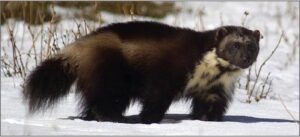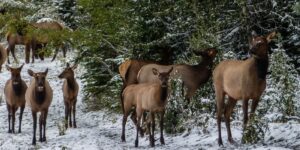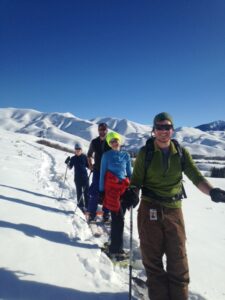While many Idahoans spend their summers playing in the outdoors, wildlife in the high country are hard at work preparing for the winter ahead. Animals spend their summer building up their fat reserves to increase their likelihood of winter survival. As winter settles in, animals typically head into hibernation or begin migrating to low elevation winter ranges in hopes of surviving the unforgiving season. Adding to this already stressful battle is Idaho’s booming population, leading to more urban development and outdoor recreation. This increased overlap in land use between wildlife and recreationists adds stress for wildlife and increases the likelihood of human-wildlife conflicts.

Different animals have different winter habitat requirements. Wolverines, for instance, need quiet, snow-covered areas to birth and rear young toward the latter part of winter. Lynx also like their privacy, and recent studies about Canada lynx in Colorado show that lynx will modify their behavior to avoid high-use areas. Although this modified behavior ensures seclusion from humans, it limits lynx access to their primary food source, snowshoe hares. On the other hand, deer and elk often have no choice but to cohabitate with humans. Their winter ranges are typically located in lower elevation areas that have also attracted urban development. When faced with continuous human disturbance, animals are forced to change their way of life and expend their precious stored energy.
When examining winter wildlife behavior and needs, it is abundantly clear that humans hold a lot of power. We can immensely help wildlife by simply recreating responsibly. To help recreationists be responsible, government and wildlife agencies impose conditional closures or restrictions in popular areas. These help ensure wildlife do not experience unnecessary stress caused by winter recreation when snow conditions are such that those animals are already very stressed.

In early January, Blaine County, the City of Hailey, Bureau of Land Management, and Wood River Land Trust implemented a no-dog restriction for the uphill activities in Red Devil/Hangman/Quigley/Cutter hillsides and Olympia Gulch immediately east of the Woodside neighborhood in Hailey. This restriction was put in place to prevent prey species, such as elk and deer, from feeling threatened and/or stressed by domestic dogs that resemble wild predators. Similar conditional restrictions or closures could appear in other high-use areas to reduce the stress of our precious wildlife neighbors.
 To help recreationists and residents better understand the potential impacts of recreation to wintering wildlife, ICL will be hosting a virtual panel discussion on the importance of new conditional winter restrictions and closures in the Wood River Valley on February 23, 2022, at 6:30 pm MST. The panel will consist of Josh Johnson, ICL Central Idaho Conservation Associate; John Kurtz, BLM Shoshone Field Office Outdoor Recreation Planner; Mark Davidson, Blaine County Recreation District Executive Director; and Mike McDonald, Idaho Department of Fish and Game Magic Valley Region Wildlife Manager.
To help recreationists and residents better understand the potential impacts of recreation to wintering wildlife, ICL will be hosting a virtual panel discussion on the importance of new conditional winter restrictions and closures in the Wood River Valley on February 23, 2022, at 6:30 pm MST. The panel will consist of Josh Johnson, ICL Central Idaho Conservation Associate; John Kurtz, BLM Shoshone Field Office Outdoor Recreation Planner; Mark Davidson, Blaine County Recreation District Executive Director; and Mike McDonald, Idaho Department of Fish and Game Magic Valley Region Wildlife Manager.
If you would like to stay in the loop with this project and other similar issues, please sign up here for regular updates on ICL’s wildlife work.
